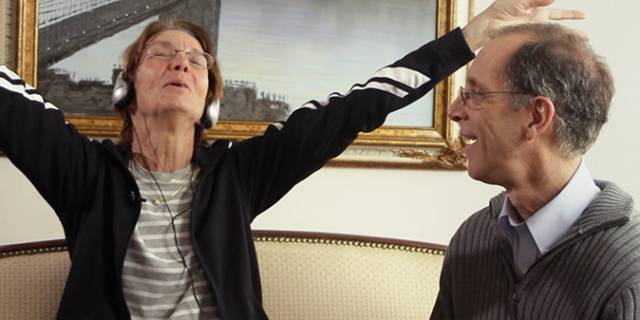
 In the touching documentary Alive Inside, Michael Rossato-Bennett follows social worker Dan Cohen as he fights a system that won’t let him (surprise, surprise!) help those in need. Cohen’s purpose is to use a simple technique to help patients with dementia recover some of their memory and reconnect to aspects of their lives they’d treasured. The simple technique involves playing them music that meant something to them. We see how their eyes, first distanced and lost, suddenly become alive as they hear the notes or lyrics to songs that remind them of special events and people.
In the touching documentary Alive Inside, Michael Rossato-Bennett follows social worker Dan Cohen as he fights a system that won’t let him (surprise, surprise!) help those in need. Cohen’s purpose is to use a simple technique to help patients with dementia recover some of their memory and reconnect to aspects of their lives they’d treasured. The simple technique involves playing them music that meant something to them. We see how their eyes, first distanced and lost, suddenly become alive as they hear the notes or lyrics to songs that remind them of special events and people.
In the film, we see Cohen unsuccessfully try to implement his technique in as many nursing homes as possible, only to be met with disapproval from drug companies, big corporate donors and a system reluctant to accept that something as simple as music could have any healing power. This is sadder because we see the effect of music in people who seconds before seemed catatonic. For example Henry (see his story here), the film’s banner figure who became famous when his video was shared on Reddit, transforms in front of us as he listens to Cab Calloway.
It seems like magic, but it’s not, and by the end of the film we are left feeling inspired by the passion and humanity of those involved in the project and frustrated by the blindness of the system. We spoke to Michael Rossato-Bennett and Dan Cohen who elaborated on the film’s themes and the status of the project.
Can you describe the moment when you realized you needed to tell this story as a film?
MRB: I think you can see it in the film. As a filmmaker you are always looking for your next story and the only way you choose is by your gut. It can be very hard to find your next story and this was an amazing experience. From the first moment I felt Henry waking up I felt it so deeply inside of my guts. This is something that moves you, it’s very profound. Making a film is not easy, there isn’t a lot of support most of the time, but I felt that this human awakening was so powerful that it could cut through the noise, it awoke my heart in a way few things ever have. That line between being dead and asleep that moment is what we all want. Here was an opportunity to awaken an enormous sleeping population.
Dan, have you tried to implement this project in countries where alternative medicine is more accepted?
DC: I’m not an expert on cross cultural medical systems, but I know for example that in the Netherlands when the video went viral people wanted to know more about the project. People in Holland said this is great, we want to get it started and they did, they went for it.
Why do you think that you were met with such opposition from the institutions we see in the film?
DC: Systems in general are resistant to change, people are comfortable, it takes a lot of effort to make changes. You see in the film that people have already tried changing the nursing home system, but it’s been a very heavy process.
Do you feel that some might think that your theory has too much heart and soul and not enough science?
DC: I disagree, in the film you see interviews and facts from medical doctors and scientists, who in fact have helped diffuse many of the objections. I believe that the heart and soul compliments scientific facts, and we have both in the film, they’re beautifully intertwined.
Can you discuss about the scenes you had to leave out in the cutting room?
MRB: This was a very hard film to make because you easily could have four different films in here. It looks at topics that most people don’t want to look at. There was also a joy and excitement and aliveness that this made me feel, which helped me in the editing room. I was informed by the things I found powerful, things that would inspire people. My choice was to tell a story that honored the most beautiful part in these people and people who want to make a change, my focus was to bring delight to the viewers.
What has been the most touching reaction you’ve seen so far?
MRB: This movie is meant to be seen with an audience, people come up to us in tears and start sharing their stories with us, “I’m a musician...”, “if I’d only thought this was possible”. People want to help, we have had many people come to us and say “this movie has changed my life” but perhaps my favorite part is to see 300-500 human souls looking back at me when we do Q&A’s afterwards, with sweet looks on their faces and not a single closed soul. I feel connecting to what they see in the film, helps open people. Everyone feels very competitive nowadays and they often forget beauty, our nature is art.
“Alive Inside” opens in theaters on July 18. For more about the project visit MusicandMemory.org